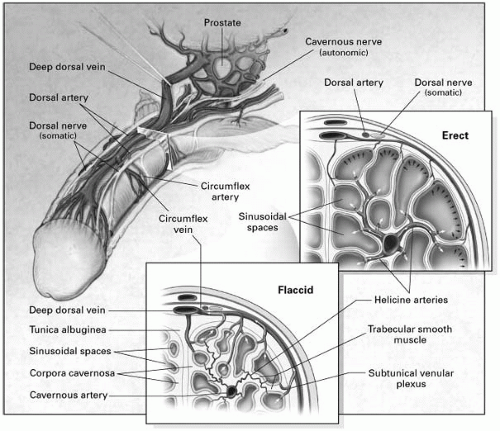The differential diagnosis of ED includes a variety of etiologies (
Table 24.2). Aside from organic psychiatric causes of ED, a number of well-recognized stressors can trigger performance anxiety including anger, alienation, and depression. Mental illness and drugs used to treat them can commonly cause ED. Commonly prevalent risk factors that are implicated in atherosclerosis such as smoking, high cholesterol, and diabetes mellitus can all cause ED. Systemic disorders such as diabetes, chronic renal failure, and even aging can commonly contribute to ED via a combination of factors including neuronal and vascular dysfunctions.
Organic Causes of Erectile Dysfunction
Neurologic. Damage to the CNS from cerebrovascular accidents and degenerative processes such as Alzheimer’s or Parkinson’s disease may all result in ED. Similarly, damage to the peripheral nervous system as may ensue from spinal cord injury, diabetic neuropathy, and vascular or prostate surgery are common causes of ED.
Endocrine. Testosterone deficiency causes both decreased libido and an inability to maintain an erection secondary to low levels of nitric oxide synthase. In addition, hyperprolactinemia, hyperthyroidism, and hypothyroidism can all cause ED. In these settings, normalizing hormonal levels often results in return of normal male sexual function.
Vasculogenic. Anatomic defects in the arterial and venous systems may cause ED. Arterial stenosis and vasodilator dysfunction secondary to atherosclerosis can prevent adequate blood flow to the penis for an erection and are the most common causes of ED. Arterial stenosis involving the aortoiliac blood vessels resulting in claudication in one or both legs, diminution in femoral pulses, and ED is referred to as Leriche’s syndrome. Venous dysfunction causing failure of veins to close during an erection may prevent the maintenance of an erection. Causes of abnormal venous drainage include Peyronie’s disease, aging, and diabetes mellitus.
Medications.
Table 24.3 lists common medications that should be considered during the evaluation of ED.




